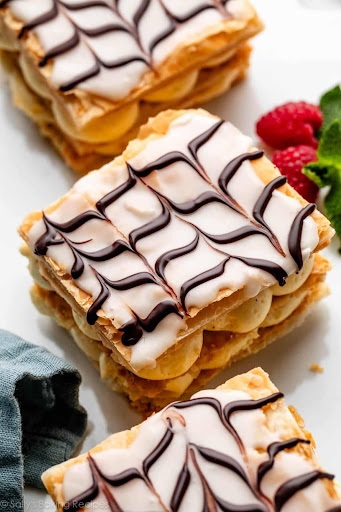Flaky, Fancy, Foolproof: Tips for a Perfect Mille Feuille
Hello Chefs,
Today in culinary school we tackled a true pastry classic: the Mille-feuille (aka “Napoleon” for those of us less inclined to speak fluent French pastry). And let me tell you—it was spectacular.
Imagine: crisp, golden layers of flaky pastry stacked with silky pastry cream, sometimes topped with fondant or powdered sugar, and always a little bit fancy. Mille-feuille means “a thousand sheets,” and while it doesn’t have quite that many layers, it sure feels like it when you’re making it.

🧈 A Truth Bomb from Culinary School
Here’s something we learned that might surprise you—and liberate you:
Almost no one makes puff pastry from scratch.
Yes, we spent hours in class rolling, folding, chilling, and repeating to create puff pastry dough by hand. And yes, it’s a great skill to have under your chef’s belt. But the truth is: even most professional chefs don’t make it from scratch on a regular basis.
Why?
Because store-bought puff pastry is actually really good. Like… really.
Unless you’re entering a pastry competition or working at a Michelin-starred patisserie, you’re totally allowed to use store-bought dough—and feel great about it.
So if you’re a purist like me, I’m here to give you permission: buy the puff pastry. You’ll save hours, your sanity, and still get an incredible result. Use your precious time to make other fun components instead!
But hey—if you want to make your own, go for it! Just know you’ll be in the minority of pastry overachievers, and we’ll all cheer you on from the comfort of our defrosted dough.
🍰 Tips for a Show-Stopping Mille-Feuille
Whether you’re using homemade or store-bought dough, these tricks will help you nail it:
1. Bake Between Two Sheet Pans
Puff pastry has a mind of its own. To keep your layers from puffing up too high or unevenly, bake them between two parchment-lined sheet pans. This gives you crisp, flat layers perfect for stacking.
2. Dock the Dough
Use a fork to poke holes all over the surface before baking—this helps release steam and keeps the pastry from ballooning too much.
3. Trim After Baking
For clean edges, wait until the pastry is fully baked and cooled, then trim the sides with a serrated knife. Don’t try to force perfection while it’s hot or soft.
4. Chill Before Slicing
Mille-feuille is notoriously tricky to slice without smushing. Chill the assembled dessert until firm before cutting—and use a sharp serrated knife with a gentle sawing motion.
5. Keep the Layers Dry
To prevent sogginess, you can add a light dusting of powdered sugar, melted chocolate, or even a thin layer of cooled caramel to the top of each pastry layer before stacking. It adds structure and flavor.
✨ Filling & Flavor Tips
- Classic filling: Pastry cream (crème pâtissière) is the gold standard. You can flavor it with vanilla bean, espresso, citrus zest, or even a bit of liqueur.
- Optional layers: Try thin layers of jam, fresh berries, whipped cream, or ganache.
- Toppings: Traditional mille-feuille is finished with a fondant glaze and chocolate feathering, but powdered sugar or a caramel glaze works beautifully too.
So whether you’re using the store-bought dough (like 99% of us) or hand-rolling every butter-packed layer, just know this: Mille-feuille is absolutely worth making. It’s the kind of dessert that makes jaws drop, forks clatter, and guests swoon.
Here is the recipe for the Mille-feuille
Until next time, stay flaky and fabulous!
 Brennah Van Wagoner
Brennah Van Wagoner
Weekly Newsletter Contributor since 2025
Email the author! brennah.oaks@gmail.com
